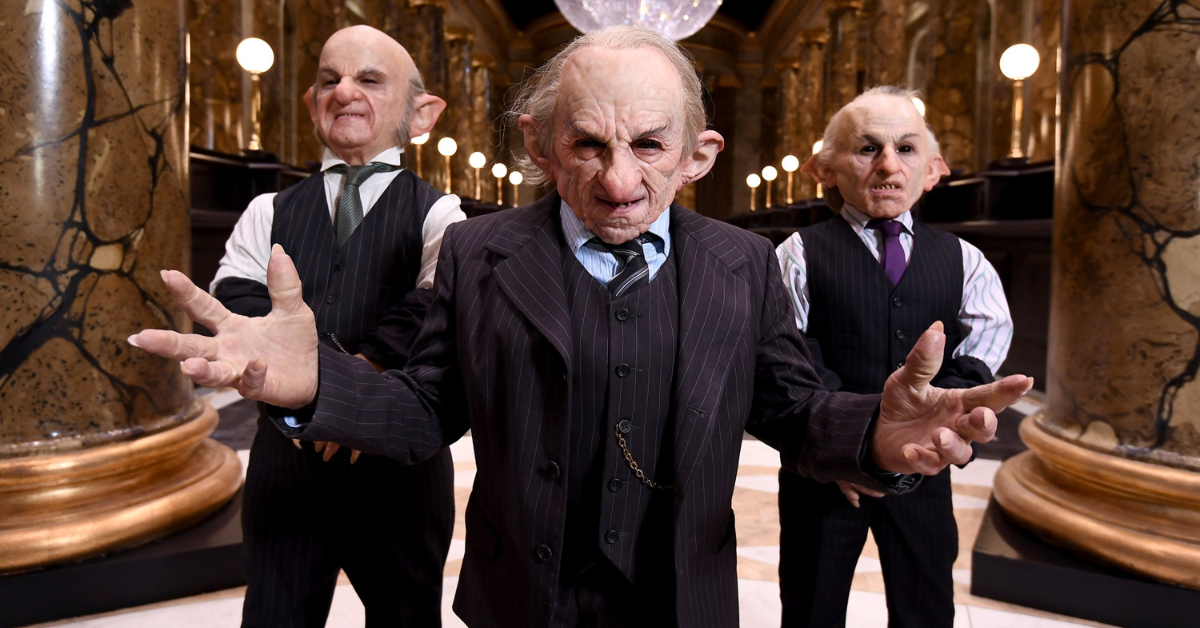
Wands are a crucial and commonly discussed aspect of the Harry Potter series. They serve as the tool that allows witches and wizards to channel and harness their magical abilities.
Throughout the series, the significance of wands is highlighted through the emphasis on wand lore, the notion of wand ownership, and the pivotal role wands play in duels and magical combat.
Recommended for You:- What If Voldemort WON? The Wizarding World’s DARK Future
- Hagrid’s Secret: Why He’s Not Really Poor After All
- Why Dumbledore Hid a Secret in the Mirror: 7 Shocking Truths Harry Missed
- What Made the Deathly Hallows So Strong? Unraveling the Powerful Magic
Goblins and Wand Ownership
But for some reason, goblins aren’t allowed to use them. Goblins are given full control of the financial system, they’re more than magically capable, and they’re arguably more intelligent than wizardkind.
However, under the current Ministry of Magic’s control, goblins are still prohibited from using or owning wands, under the severe consequence of a life sentence in Azkaban prison.
Questions to Consider
- Why are goblins forbidden from owning wands?
- How powerful could they become if they did possess wands?
- What underlying tensions exist between the goblin race and wizards?
Today we will discuss the history of wizards and goblins, uncovering the truth behind why goblins have so few rights in magical society.
Historical Context and Tensions
It shouldn’t come as any surprise when I tell you that goblins haven’t been treated well over the course of wizarding history. Purebloods outright hated them, and even the most progressive members of the wizarding world felt a general mistrust for the tiny, monstrous humanoid creatures.
Sources of Animosity
- Historical Conflicts: There has been conflict upon conflict between wizards and goblins, with the goblins rebelling on numerous occasions.
- Perception of Goblins: Wizards typically treated other human-like creatures like giants with a fair bit of fear, but they never really outwardly displayed the same concern for goblins.
If we spend more time talking about the early relationship between wizards and the goblin community, we’ll find a peculiar niche that the shorter, more monstrous creatures developed for themselves.
Goblins were extremely talented in a handful of things. For starters, they were incredibly smart, and the word often used to describe them was cunning. This, combined with their love for precious metals, made them great gold and silversmiths.
The Sword of Godric Gryffindor
At one point in the 11th century, the goblins even crafted the sword of Godric Gryffindor, the very same blade that would serve Gryffindor’s heirs in the centuries to come. But the weapon’s origins are far darker than you might guess.
- Cultural Differences: Among the many cultural differences that brought strife to wizards and goblins in the Middle Ages, the most contentious idea was that of ownership. To wizards, it was simple: if you bought something, then you owned it. But to goblins, it was far more complex.
- Goblin Beliefs: To goblins, ownership always belonged to the creator of the item, and when wizards tried to pass down their goblin-forged heirlooms, it wasn’t uncommon for goblins and wizard heirs to come to blows.
Even before Godric died, the sword’s creator, King Ragnok, tried to manipulate his fellow magical creatures into stealing the blade. That’s how much he loved the weapon.
In the years following Gryffindor’s death, Ragnok and his fellow goblins were insulted even more as the sword stayed in Hogwarts, and passed through the hands of wizard heirs for nearly 1000 years. This tale, and others like it, were one of the main sources of resentment that launched the goblin rebellions.
Goblin Rebellions and Aftermath
In the present day, tensions have lowered, but things certainly have a long way to go. Goblins are in charge of Gringotts Wizarding Bank, overseeing all of the responsibilities associated with currency in the wizarding world.
This more modern era shows that the more progressive members of wizarding society have almost started to treat them as equals. But the goblins’ history with Gringotts actually goes back a long way, all the way to 1474 when they first founded it.
Key Historical Events
- Foundation of Gringotts (1474): Goblins were entrusted with the wealth of the British wizarding community.
- Goblins’ Role: For centuries, goblins patiently managed the banks and almost all of the finance in the wizarding world, and for that reason and more, they were among the most important beings in the entire magical community.
However, even in the decades that followed Gringotts’ foundation, goblins continued to suffer harsh treatment from human wizards.
The Goblin Rebellion of 1612
The goblin rebellion of 1612 is a significant historical event that historians decided to pay attention to and record. We’re not quite certain about the exact location, but it seems that this armed conflict arose in or around Hogsmeade village. The goblin forces took an inn as their base and ravaged the nearby buildings, setting many of them on fire.
- Casualties: The exact number of lives laid down on both sides has been lost to the years, but the casualties were remarkably high.
- Goblins’ Importance: At a glance, the average goblin was far more important to the lives of wizards and witches around England, responsible for far more skilled tasks than house elves.
Goblins forged the most powerful weapons, indestructible armor, and through their natural propensity for hoarding gold, goblins basically kept the entire wizarding economy moving forward. Yet, wizards and witches looked down on them wherever they went.
Code of Wand Use
- Wandless Magic: Wizards almost always refused to teach goblins the ways of wand lore, which meant that goblins had to accomplish their magical feats with the far more difficult and dangerous technique of wandless magic.
- Wizzengamot: Even the highest court in Britain, the Wizzengamot, refused to allow a goblin a seat, leading to the goblins’ rebellion in 1612.
While the 1612 goblin rebellion was probably necessary to begin the process of igniting any sort of change, it didn’t change anything by itself. In fact, it made things worse.
In response to the display of violence in Hogsmeade, the wizarding community of Britain convened and created a series of laws that restricted non-human magical creatures.
- Code of Wand Use: The harshest among them was the new Code of Wand Use, which the wizard’s council passed less than two decades after the rebellion. This code comprised a total of eight clauses that outlined the regulations concerning the use of wands, restricting wands to human wizards, and making it a crime for goblins, house elves, giants, and other non-humans to wield them.
Modern Day and Goblin Rights
At a glance, you can see how this law made it almost impossible for goblins to defend themselves from wand-armed wizards and witches.
The restriction on wand ownership completely hindered the ability of goblins to develop independently of the wizarding community, meaning they would always depend on wizards. This wasn’t the last time that the goblins would fight for their rights.
Subsequent Rebellions
Eventually, the goblins led a second rebellion that led to the resignation of two ministers and came very close to achieving victory. Despite these events, the Ministry has remained steadfast in its refusal to amend the Code of Wand Use under any circumstances.
- Wand Ownership: Wand ownership is almost a rite of passage in wizarding society. It represents the beginning of your personalized journey into discovering your capabilities. It’s special, but goblins are excluded from this, and it just doesn’t seem fair.
The Brotherhood of Goblins
In recent times, the Brotherhood of Goblins, an advocacy group fighting for goblin rights, has persistently protested against these laws, but they’ve yet to see any sort of success.
Key Questions
- Why keep wands out of the hands of goblins?
- Is it a matter of principle, or is there something else at play here?
The first thing to consider is that goblins are not human and possess unique DNA and magical characteristics akin to elves.
Their innate magical abilities operate differently from those of humans, with magic flowing through them in a distinct manner. This raises the question of whether goblins, who excel in wandless magic, could potentially wield a wand more effectively than humans.
Perceived Threat
It’s the perceived threat of goblins potentially using wands to challenge wizarding authority and power that is a significant factor in the prohibition.
The Code of Wand Use could very well be a precautionary measure to maintain the current power dynamics within the magical society, as allowing goblins access to wands could disrupt the established order.
Furthermore, the Ministry’s hesitation to grant goblins the same magical rights as wizards might be deeply rooted in prejudiced beliefs about the abilities and trustworthiness of goblins.
And that’s it for this blog! What do you think about the way that goblins are treated in Harry Potter? If they were given wands, would they pose a threat to wizardkind? Let me know in the comment section below.



